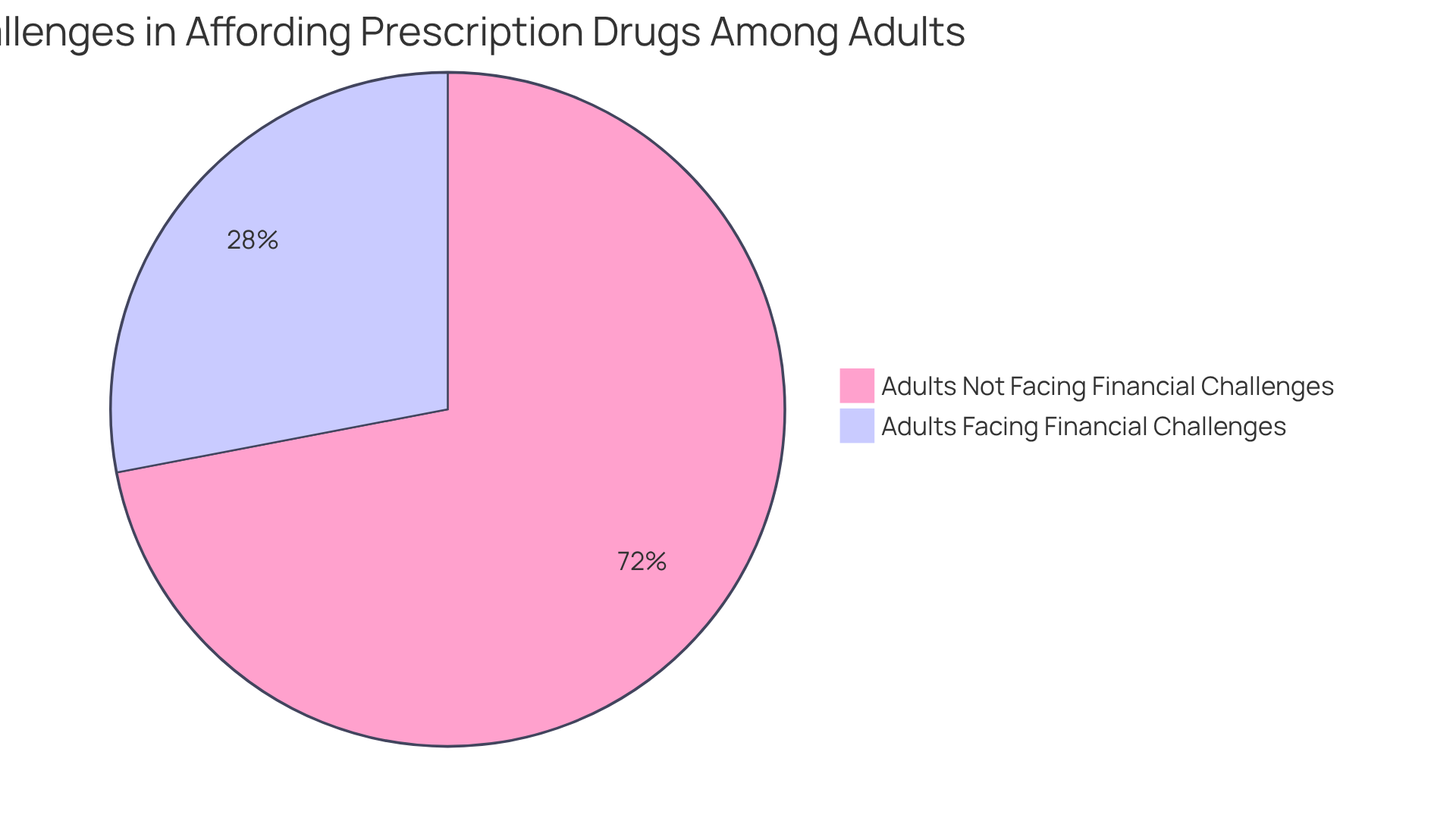Overview
This article seeks to shed light on the costs associated with compounded tirzepatide for weight loss, recognizing that prices can vary significantly, ranging from $200 to over $1,000 monthly. This variation depends on several factors, and it’s important to note that many insurance plans do not cover these expenses. Such financial barriers can feel overwhelming for those on a weight loss journey, as the lack of insurance coverage and high costs may limit access to essential medications.
We understand how these challenges can impact your health outcomes and overall well-being. It’s crucial to acknowledge the emotional weight that comes with seeking effective weight loss treatments. Together, we can explore ways to navigate these obstacles and find support. Remember, you are not alone in this journey, and there are steps you can take to advocate for your health and access the treatments you need.
Introduction
Understanding the financial implications of compounded tirzepatide is essential for those of us seeking effective weight loss solutions. This personalized medication, designed to mimic the key hormones that regulate appetite and glucose levels, offers a promising option for individuals battling obesity. However, the costs associated with compounded tirzepatide can vary significantly, often leaving patients feeling overwhelmed by affordability and access issues.
How can we navigate this complex landscape together to make informed choices about our health and treatment options?
It’s important to recognize that you’re not alone in this journey. Many individuals share similar concerns about the financial aspects of their weight loss treatments. By exploring the options available and understanding the potential costs, you can take proactive steps toward achieving your goals.
Remember, we’re here for you, and together, we can find the best path forward.
Define Compounded Tirzepatide: Understanding the Medication
Compounded medication offers a personalized approach to managing obesity and type 2 diabetes, providing hope for those on their weight loss journey. This tailored formulation mimics the effects of two essential hormones—glucagon-like peptide-1 (GLP-1) and glucose-dependent insulinotropic polypeptide (GIP)—which play a vital role in appetite control and glucose metabolism. By working with compounding pharmacies, patients can receive specific dosages or formulations that may not be available in standard commercial preparations, ensuring that their unique needs are met.
While these compounded medications present personalized treatment options, it’s important to understand that they are not FDA-approved. This lack of regulatory oversight can raise questions about their safety and efficacy compared to commercially available alternatives. However, recent studies highlight the potential of this drug in achieving significant weight loss, with participants in clinical trials experiencing an average weight decrease of 20.2%. Additionally, it shows promise in preventing the progression to type 2 diabetes, making it an appealing option for individuals facing obesity challenges.
Healthcare professionals emphasize the importance of monitoring and personalized care when utilizing compounded treatments. It’s essential for patients to consult with their healthcare providers to carefully weigh the benefits against the risks associated with these formulations. For those considering the cost of compounded tirzepatide, it is typically administered via injection once a week in the upper arm, thigh, or stomach, and proper storage according to your healthcare provider’s instructions is crucial.
As with any medication, potential side effects such as nausea, vomiting, and gastrointestinal discomfort should be discussed with a healthcare provider. At Minimal, we believe in providing accessible health solutions, starting at just $49 for the first month. Our approach is budget-friendly for those seeking effective management solutions. By combining weight loss strategies with fitness training and nutrition guidance, Minimal positions itself as a holistic wellness brand dedicated to supporting individuals in achieving their health goals. Remember, together, we can navigate this journey toward better health.
Analyze Cost Factors: Pricing and Insurance Coverage
Navigating the cost of compounded tirzepatide can be challenging, and understanding how various factors—such as the pharmacy, dosage, and insurance coverage—can influence the cost is important. Typically, you might find that prices range from $200 to $600 per month, depending on the formulation and dosage prescribed. However, the cost of compounded tirzepatide can exceed $1,000 monthly for brand-name versions such as Mounjaro and Zepbound without insurance, which can be overwhelming.
Unfortunately, many insurance plans do not cover the cost of compounded tirzepatide, which complicates access for individuals seeking treatment. We understand how daunting this can feel, and comprehending these cost dynamics is essential for effectively navigating your treatment options. Remember, you are not alone in this journey.
At Minimal, we’re here for you. We accept HSA/FSA payments and are dedicated to ensuring HIPAA compliance, which means our loss program—including a consultation to assess your health and personalized treatment plans—is both accessible and secure. Together, we can achieve your goals and find the right support for your needs.
Evaluate Patient Access: Impact of Cost on Treatment Choices
The considerable expense of compounded alternatives and the cost of compounded tirzepatide, along with their branded counterparts, poses a significant challenge to patient access for effective weight loss treatments. Many individuals struggling with obesity may find that the cost of compounded tirzepatide is prohibitively expensive, often feeling compelled to turn to less effective or unverified options. At Minimal, we understand that a holistic approach is essential for sustainable health improvements. Our weight loss program begins with a compassionate consultation to assess your health and determine the best treatment plan, which may include potential prescription options like tirzepatide. We combine these treatments with personalized fitness and nutrition strategies to foster long-term success.
The lack of insurance coverage for compounded pharmaceuticals adds another layer of complexity, especially considering the cost of compounded tirzepatide, as Medicare currently does not cover weight-loss drugs, and Medicaid coverage varies by state. This inconsistency can discourage patients from exploring options that might better suit their needs. The financial strain associated with the cost of compounded tirzepatide and these treatments can lead to discontinuation, adversely impacting health outcomes. Research indicates that three in ten adults (28%) find it somewhat or very challenging to afford prescription drugs, underscoring the urgent need to address these access issues.
As Dr. Alison P. Galvani states, “Expanding access to these drugs is not just a matter of improving treatment options but also a crucial public health intervention.” By tackling these financial obstacles, the healthcare system can enhance the overall efficiency of obesity management strategies, ensuring that individuals receive the necessary support to achieve their health goals. Moreover, if the availability of new treatments were expanded, the U.S. could potentially see up to 42,027 fewer deaths annually. This highlights the essential need for addressing financial barriers in obesity management. Together, we can work towards a healthier future.
Explore Alternatives: Other Weight Loss Medications
Navigating the path to weight loss can feel overwhelming, but there are compassionate options available. Along with compounded medications, patients have access to a variety of treatments designed to support their journey, including considerations about the cost of compounded tirzepatide. Semaglutide (Wegovy), a GLP-1 receptor agonist, has garnered attention for its effectiveness. Studies indicate that participants can achieve an average weight loss of approximately 15-20% over a year. Even more encouraging, tirzepatide has shown even greater effectiveness, with users losing an average of 20.2% of their body mass during the same period—about 50 pounds.
Wegovy works by mimicking the action of the hormone glucagon-like peptide-1 (GLP-1). This helps regulate appetite and food intake, promoting feelings of fullness and reducing hunger. Administered via a subcutaneous injection once a week, it can be easily injected in the thigh, abdomen, or upper arm. Liraglutide (Saxenda), a long-standing option for managing body mass, also contributes to the range of available treatments, although its average reduction is lower, around 5-10%.
Other alternatives include:
- phentermine-topiramate (Qsymia)
- orlistat (Alli)
These work through different mechanisms to facilitate weight loss. Each medication presents unique benefits and potential side effects. For instance, gastrointestinal disturbances are commonly associated with GLP-1 receptor agonists, affecting about 80% of users. This highlights the importance of engaging in open discussions with healthcare providers to identify the most suitable treatment tailored to individual health goals and the cost of compounded tirzepatide.
As Dr. Chance Miller emphasizes, “Clients appreciate the personalized attention from a dedicated care team, which includes physicians who emphasize transformative care.” By exploring the full spectrum of available options, including the potential side effects and administration methods of Wegovy, patients can make informed decisions that align with their weight management objectives. Remember, together, we can achieve your goals, and we’re here to support you every step of the way.
Conclusion
Compounded tirzepatide represents a significant advancement in the personalized treatment of obesity and type 2 diabetes, offering tailored solutions that target appetite control and glucose metabolism. While these compounded formulations provide hope for many, it is crucial to navigate the complexities surrounding their cost and insurance coverage. Understanding these dynamics is essential for making informed decisions about treatment options that align with individual health goals.
Throughout this discussion, we highlight the effectiveness of compounded tirzepatide in promoting substantial weight loss. However, we also acknowledge the challenges posed by its cost and the lack of insurance coverage that complicates access for patients. It’s important to consider potential side effects and consult healthcare professionals, as they play a vital role in ensuring the safe and effective use of this medication. Additionally, exploring alternative weight loss medications underscores the need for a comprehensive approach to obesity management.
Addressing the financial barriers associated with compounded tirzepatide is not merely a matter of individual concern; it reflects a broader public health issue that necessitates collective action. By advocating for improved access to affordable treatment options and fostering open dialogues about the available alternatives, we can better support individuals on their weight loss journeys. Ultimately, empowering patients with knowledge and resources can lead to healthier outcomes and a more equitable healthcare landscape. Together, we can achieve your goals and create a supportive community for those seeking to improve their health.
Frequently Asked Questions
What is compounded tirzepatide?
Compounded tirzepatide is a personalized medication designed to help manage obesity and type 2 diabetes. It mimics the effects of two hormones, glucagon-like peptide-1 (GLP-1) and glucose-dependent insulinotropic polypeptide (GIP), which are important for appetite control and glucose metabolism.
How does compounded tirzepatide work?
This medication works by providing tailored dosages and formulations that may not be available in standard commercial preparations, addressing the unique needs of patients in their weight loss journey.
Is compounded tirzepatide FDA-approved?
No, compounded tirzepatide is not FDA-approved, which raises questions about its safety and efficacy compared to commercially available alternatives.
What are the potential benefits of compounded tirzepatide?
Recent studies indicate that participants in clinical trials experienced an average weight loss of 20.2% and that the medication shows promise in preventing the progression to type 2 diabetes.
How is compounded tirzepatide administered?
Compounded tirzepatide is typically administered via injection once a week in the upper arm, thigh, or stomach.
What should patients consider before using compounded tirzepatide?
Patients should consult with their healthcare providers to assess the benefits and risks of using compounded formulations and ensure personalized care and monitoring.
What are some potential side effects of compounded tirzepatide?
Potential side effects include nausea, vomiting, and gastrointestinal discomfort, which should be discussed with a healthcare provider.
How much does compounded tirzepatide cost?
Compounded tirzepatide is available starting at $49 for the first month through Minimal, which also offers additional support for weight loss strategies, fitness training, and nutrition guidance.





















